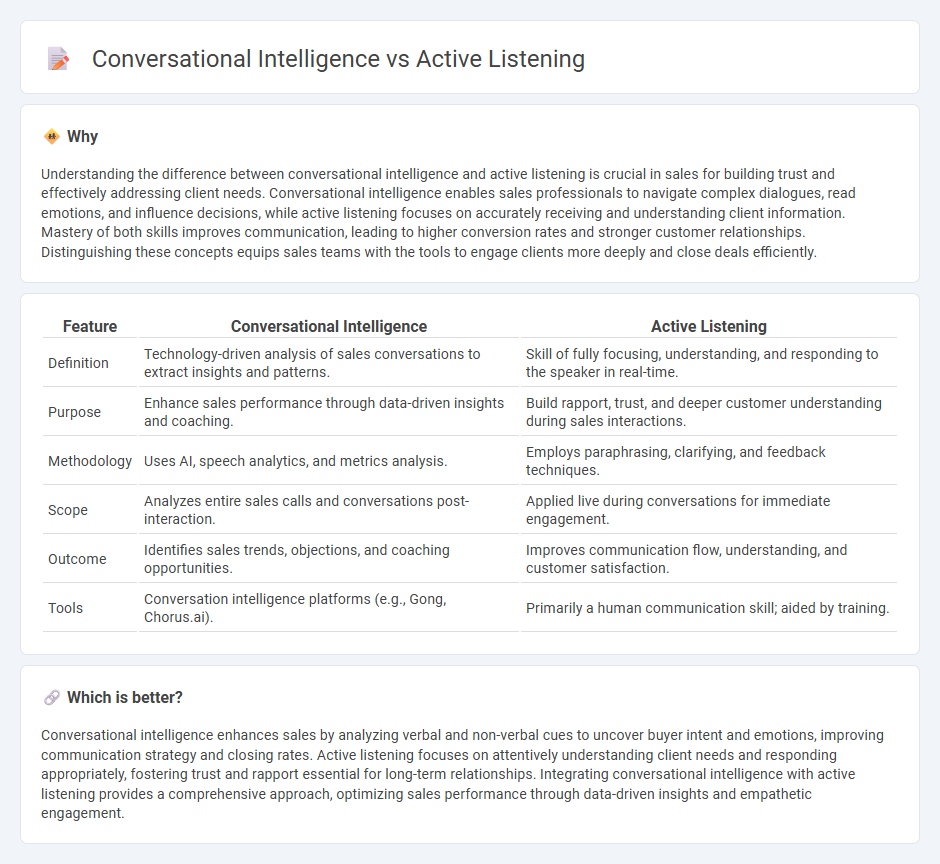
Conversational intelligence enhances sales by analyzing tone, word choice, and conversation patterns to uncover customer intent and emotional cues, driving more effective engagement. Active listening focuses on attentively understanding and responding to customer needs, fostering trust and rapport during sales interactions. Discover how combining conversational intelligence with active listening can transform your sales strategy.
Why it is important
Understanding the difference between conversational intelligence and active listening is crucial in sales for building trust and effectively addressing client needs. Conversational intelligence enables sales professionals to navigate complex dialogues, read emotions, and influence decisions, while active listening focuses on accurately receiving and understanding client information. Mastery of both skills improves communication, leading to higher conversion rates and stronger customer relationships. Distinguishing these concepts equips sales teams with the tools to engage clients more deeply and close deals efficiently.
Comparison Table
| Feature | Conversational Intelligence | Active Listening |
|---|---|---|
| Definition | Technology-driven analysis of sales conversations to extract insights and patterns. | Skill of fully focusing, understanding, and responding to the speaker in real-time. |
| Purpose | Enhance sales performance through data-driven insights and coaching. | Build rapport, trust, and deeper customer understanding during sales interactions. |
| Methodology | Uses AI, speech analytics, and metrics analysis. | Employs paraphrasing, clarifying, and feedback techniques. |
| Scope | Analyzes entire sales calls and conversations post-interaction. | Applied live during conversations for immediate engagement. |
| Outcome | Identifies sales trends, objections, and coaching opportunities. | Improves communication flow, understanding, and customer satisfaction. |
| Tools | Conversation intelligence platforms (e.g., Gong, Chorus.ai). | Primarily a human communication skill; aided by training. |
Which is better?
Conversational intelligence enhances sales by analyzing verbal and non-verbal cues to uncover buyer intent and emotions, improving communication strategy and closing rates. Active listening focuses on attentively understanding client needs and responding appropriately, fostering trust and rapport essential for long-term relationships. Integrating conversational intelligence with active listening provides a comprehensive approach, optimizing sales performance through data-driven insights and empathetic engagement.
Connection
Conversational intelligence enhances sales by enabling representatives to decode customer cues and respond with relevant solutions, increasing engagement and trust. Active listening plays a crucial role by allowing sales professionals to accurately capture client needs, preferences, and pain points, leading to more personalized pitches. Together, these skills optimize communication dynamics, driving higher conversion rates and stronger client relationships.
Key Terms
Active Listening:
Active listening involves fully concentrating, understanding, and responding thoughtfully to the speaker, enhancing communication effectiveness and building trust in interpersonal relationships. It requires mindful attention, non-verbal cues like nodding, and paraphrasing to confirm comprehension. Discover more strategies to master active listening and improve your conversational skills.
Paraphrasing
Active listening emphasizes accurately paraphrasing the speaker's message to confirm understanding and demonstrate empathy, fostering trust and clarity in communication. Conversational intelligence leverages paraphrasing not only to validate information but also to build deeper relational bonds and enhance collaborative problem-solving. Explore the nuances of paraphrasing techniques in both approaches to elevate your communication skills.
Nonverbal Cues
Active listening emphasizes interpreting nonverbal cues such as eye contact, facial expressions, and body language to enhance understanding and connection. Conversational intelligence expands this focus by decoding subtle nonverbal signals to build trust, foster collaboration, and influence outcomes in conversations. Explore how mastering these nonverbal elements can transform your communication skills.
Source and External Links
Active listening - Wikipedia - Active listening is the practice of preparing to listen, observing verbal and non-verbal messages, and providing feedback to fully understand and build mutual understanding between speaker and listener.
What Is Active Listening? Definition, Skills, and Examples - Active listening involves skills like restating and paraphrasing what the speaker says to confirm facts and reflect meaning, which deepens conversation and prevents misunderstandings.
Effective active listening: Examples, techniques & exercises - Active listening requires focused attention on the speaker, avoiding interruptions, paraphrasing to confirm understanding, and asking open-ended questions to foster meaningful communication.
 dowidth.com
dowidth.com